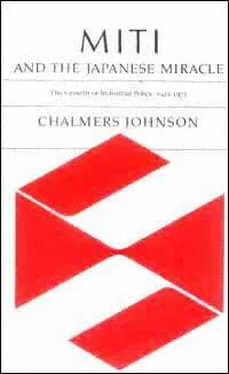Chalmers Johnson - MITI and the Japanese miracle
Здесь есть возможность читать онлайн «Chalmers Johnson - MITI and the Japanese miracle» весь текст электронной книги совершенно бесплатно (целиком полную версию без сокращений). В некоторых случаях можно слушать аудио, скачать через торрент в формате fb2 и присутствует краткое содержание. Год выпуска: 2007, Издательство: Stanford University Press, Жанр: Старинная литература, на английском языке. Описание произведения, (предисловие) а так же отзывы посетителей доступны на портале библиотеки ЛибКат.
- Название:MITI and the Japanese miracle
- Автор:
- Издательство:Stanford University Press
- Жанр:
- Год:2007
- ISBN:нет данных
- Рейтинг книги:3 / 5. Голосов: 1
-
Избранное:Добавить в избранное
- Отзывы:
-
Ваша оценка:
- 60
- 1
- 2
- 3
- 4
- 5
MITI and the Japanese miracle: краткое содержание, описание и аннотация
Предлагаем к чтению аннотацию, описание, краткое содержание или предисловие (зависит от того, что написал сам автор книги «MITI and the Japanese miracle»). Если вы не нашли необходимую информацию о книге — напишите в комментариях, мы постараемся отыскать её.
MITI and the Japanese miracle — читать онлайн бесплатно полную книгу (весь текст) целиком
Ниже представлен текст книги, разбитый по страницам. Система сохранения места последней прочитанной страницы, позволяет с удобством читать онлайн бесплатно книгу «MITI and the Japanese miracle», без необходимости каждый раз заново искать на чём Вы остановились. Поставьте закладку, и сможете в любой момент перейти на страницу, на которой закончили чтение.
Интервал:
Закладка:
Kenkyusha's
*
New Japanese-English Dictionary
(4th ed.) gives for kondankai the Italian word
conversazione
, "a verbal agreement between two or more parties," which suggests something less than a contract but considerably more than a "conversation."
Articles 5 and 6 required managers of designated industries to cooperate in raising the competitive ability of their firms, said that banks had to "give heed to" loan requests from designated industries, and ordered government banks to assist them. Articles 7 and 8 provided for "structural financing" for designated industries, various tax exemptions to be specified by cabinet orders, and reductions in the corporate income tax. Article 9 legalized "cooperative behavior" by enterprises in a designated industry and specifically exempted such behavior from the purview of the Antimonopoly Law. Articles 10, 11, 12, and 13 were given over to legal technicalities. Like most Japanese statutes, the Special Measures Law was comparatively short.
25
Disclosure of the contents of the law in the Industrial Structure Investigation Council immediately set off three major controversies. The first was the old favorite of self-coordination versus public-private cooperation. Much in the tradition of Kobayashi Ichizo* at the time of Prince Konoe's New Structure Movement, Ishizaka Taizo*, the
Page 259
venerable head of Keidanren, let it be known that he favored self-imposed control. He went on to say that "all the government has to do is watch for fires and thieves. It can leave the rest of work up to civilians"; but he also believed that "opponents of foreign investment are like grown men wearing diapers, refusing to leave their mothers' breasts."
26
Although Keidanren refused to support the bill, Sahashi did gain the support of its rival organization, the Japan Committee for Economic Development (Keizai Doyukai*).
The second controversy concerned the law's stipulation that banks and bankers be included in the various "discussion groups." Leaders of the banking community concluded, accurately, that this was a direct attack on their keiretsu; and the Ministry of Finance responded with indignation to this intrusion into its territory by MITI. Usami Makoto, president of the Mitsubishi Bank and then chairman of the National Banking Association (Zenkoku Ginko* Kyokai*), refused to have anything to do with the Special Measures Law.
The third controversy was generated by the Fair Trade Commission and its belief that Sahashi was trying to get rid of the Antimonopoly Law once and for all. On December 5, 1962, Sahashi opened negotiations with the FTC concerning the purposes of the law, the threat posed by liberalization to Japan's economy, and the need for cartels. After some six meetings Sahashi seemed to have made some headway with the commission, and on February 1, 1963, the ministry published the law. Nevertheless, after the matter went to the cabinet, Ikeda still had to order the FTC to cooperate.
Sahashi's main backing in these disputes came from the Industrial Structure Investigation Council. The Industrial Order Committee (headed by Professor Arisawa), which Sahashi had consulted on every step he took, was his main bastion of strength, but during October 1962 the Industrial Finance Committee (Sangyo* Kin'yu* Bukai) also contributed its support. Headed by Nakayama Sohei of the Industrial Bank, and with only four other members (former MITI Vice-Minister Ueno, the president of a paper company, a newspaper executive, and the president of the Export-Import Bank), the committee concluded that adding banks to the discussion groups was an excellent idea and long overdue.
Given the general furor, the politicians had no choice but to step in and try to resolve these numerous issues. On February 14, 1963, Prime Minister Ikeda ordered all the economic ministers in the cabinet to meet with him on a regular basis until the law's future was decided. Hardly a week after this group went to work, the Kansai Branch of Keidanren expressed its formal opposition to MITI's pro-
Page 260
posed evisceration of the Antimonopoly Law (as we shall see, there was more to this opposition from Osaka than met the eye). When the ministers finally acted, they changed the name of the law to the more innocuous Special Measures Law for the Promotion of Designated Industries, put a five-year limit on it, altered the ways in which industries could be designated, and strengthened the participation of the minister of finance in the law's administration. With these changes the LDP's Political Affairs Research Council (where former Finance Ministry bureaucrats were very strong) signed on over the objections of the Banking Bureau, and on March 22, 1963, the party gave its final approval. On the same day the cabinet formally voted to sponsor the bill, and on March 25 it was introduced in the House of Representatives and referred to the Commerce and Industry Committee.
As expected, the opposition parties denounced the law as a return of bureaucratic control, the press personalized it as a "save MITI" bill, pundits referred to it as the "charge of the Sahashi brigade," and orators droned on about the demise of the "economic constitution." Sahashi spent hours answering questions in the Diet, but his problem was not with the opposition. He soon discovered that the cabinet, the LDP, and even his own minister had quietly decided not to make a fight. The Special Measures Law became known as "sponsorless legislation," meaning that the establishment had abandoned it. The bill was never defeated; it simply never came to a vote. The government introduced it in the 43rd (December 24, 1962, to July 6, 1963), the 44th (October 15 to October 23, 1963), and the 46th (December 23, 1963, to June 26, 1964) sessions of the Diet, but after having done that, LDP party leaders never lifted a finger to bring it to the floor for a vote. Officially MITI explained the law's failure as due to ''misunderstandings, [bureaucratic] sectionalism, and political tricks," and called its demise a "bitter setback."
27
But there were many in the ministry who understood what had happened. Opposition from the banking community and the Kansai business community was serious, but more serious was the fact that Sahashi himself had become an issue.
Several incidents had occurred during Sahashi's tenure as director of the Enterprises Bureau to irritate the business community in general and the business community of Osaka in particular, even when Sahashi's policies were proven sound. The best-known incident concerned the Maruzen Oil Company, whose head office is located in Osaka. Founded in 1933, Maruzen was part of the Sanwa Bank's keiretsu (also based in Osaka); it was and is a domestically owned refining and distribution company, but it had a long-term tie-up with Union Oil Company of California, which was a prime supplier of its
Page 261
crude oil. In the wake of the closing of the Suez Canal in 1956, Maruzen's president, Wada Kanji, had signed long-term shipping contracts that during the recession of 1962 turned unfavorable and threatened the company's financial viability. President Wada proposed accepting a very large loan from Union Oil to keep his company afloat, and he applied to MITI for approval of the loan under the terms of the Foreign Capital Law.
Sahashi turned him down cold, arguing that the company's own mismanagement had caused its problems, and that the introduction of foreign capital in an industry already thoroughly dominated by foreign companies was contrary to the national interest. Wada was not without political influence, which he began to mobilize to put pressure on MITI, but this pressure only caused Sahashi to become more combative. However, in the end Sahashi agreed to organize a five-man committee to try to salvage the Maruzen Oil Company. Chaired by Uemura Kogoro *, it recommended that Wada retire and that MITI negotiate the terms of the loan directly with Union Oil in order to ensure that Union did not gain control of the company. MITI accepted these recommendations: Sahashi struck a deal with Union, Miyamori Kazuo of the Sanwa Bank replaced Wada as Maruzen's new president, and the company was successfully rebuilt. But several Osaka legislators made speeches in the Diet accusing "the bureaucrat Sahashi" of throwing their local business leader Wada out into the streets.
Читать дальшеИнтервал:
Закладка:
Похожие книги на «MITI and the Japanese miracle»
Представляем Вашему вниманию похожие книги на «MITI and the Japanese miracle» списком для выбора. Мы отобрали схожую по названию и смыслу литературу в надежде предоставить читателям больше вариантов отыскать новые, интересные, ещё непрочитанные произведения.
Обсуждение, отзывы о книге «MITI and the Japanese miracle» и просто собственные мнения читателей. Оставьте ваши комментарии, напишите, что Вы думаете о произведении, его смысле или главных героях. Укажите что конкретно понравилось, а что нет, и почему Вы так считаете.












